![[Flag of Colombia]](../images/c/co.gif) (2:3)
(2:3)  image by Željko Heimer, 20 May 2001
image by Željko Heimer, 20 May 2001
Last modified: 2024-03-02 by rob raeside
Keywords: education |
Links: FOTW homepage |
search |
disclaimer and copyright |
write us |
mirrors
![[Flag of Colombia]](../images/c/co.gif) (2:3)
(2:3)  image by Željko Heimer, 20 May 2001
image by Željko Heimer, 20 May 2001
See also:
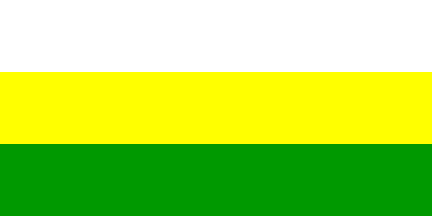 image by Ivan Sache, 22 October 2014
image by Ivan Sache, 22 October 2014
Escuela Normal Superior de Medellín (Antioquia Department) was originally
established on 1 January 1851, as Escuela de Institutores.
The flag of the institute is in proportions 1:2, horizontally divided
white-yellow-green. White is a symbol of purity and of sincere research in
humanist education and pedagogic knowledge. Yellow is a symbol of spiritual
resources and search for utopia that widens the personal and social horizon.
Green is a symbol of hope in the force of the youth and in the work of the
educationalists.
Source:
http://www.ienormalmedellin.edu.co/index2.php?id=16060&idmenutipo=1731&tag=
Ivan Sache, 22 October 2014
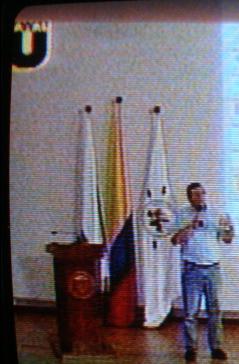 located by
Esteban Rivera, 7 September 2010
located by
Esteban Rivera, 7 September 2010
Universidad de Medellín (UDEM) was founded on 1 February 1950
by professors and students seceding from Universidad de
Antioquia, as a response to "intolerance and ideological
persecution". In 1951, the university was transferred to the
Campus of Belén los Alpes, located south-west of Medellín.
The flag of UDEM was designed by Dr. Francisco López de Mesa,
one of the founding members of the university, as a piece of
white satin, 1.80 x 2.80 m (that is, with proportions 9:14). The
emblem of UDEM, surrounded by seven red fleurs-de-lis, is placed
in the upper central part of the flag, surmounting 34 sea green
triangles, placed 1+6+11+16 and seven fleurs-de-lis argent placed
along the bottom of the flag. The flag has a golden fringe and a
Greek torch as its finial.
Each of the seven red fleurs-de-lis surrounding the emblem
represents 10 of the founders of the university watching its
progress. Each of the 34 triangles represents 5 of the 170
students founders of UDEM. Each of the seven fleurs de lis argent
represents seven of the 49 professors founders of UDEM, who form
the base of the students' pyramid.
The golden fringe is a tribute to the sponsors of the university.
The Greek torch conveys the ideals of independence and liberty of
thought.
The emblem of UDEM, also designed by Dr. Francisco López de
Mesa, is circular, with a green border symbolizing hope and
prosperity. The name of the university ("UNIVERSIDAD DE
MEDELLIN") and its motto ("CIENCIA Y LIBERTAD",
Science and Liberty) are written in golden letters in the upper
and lower part of the shield, respectively. The shield of the
university, placed over a ribbon of the Colombian colours, is
quartered. The first quarter, with a border argent, shows the logo of the town of Medellín on a
blue background. The second quarter, with a border or, is white
with a red bend sinister and a pair of scales, a symbol of
equity, also recalling that the Faculty of Law was the first
created in UDEM. The third quarter, with a border argent, is
charged with an open book whose left page is charged with a
golden Greek letter "Pi", a symbol of
sciences. The fourth quarter, with a border or, shows
on a black background a Greek torch raised by a young hand, as a
symbol of liberty, without any political, racial..., distinction.
Source: <www.udem.edu.co>.
Ivan Sache, 6 February 2010
The flag of the Universidad de Medellín
is seen here (first flag from
left to right):
http://es.wikipedia.org/wiki/Archivo:Seminario_Periodismo_Deportivo.jpg
The flag is a white horizontal flag with the
Coat of Arms in the middle, surrounded by four red fleur-de-lys in a diagonal manner
pointing to each corner of the flag.
The full description of the symbols is here:
http://www.udem.edu.co/UDEM/Institucional/Simbolos/
It is important to notice, that while the University's official website shows a
flag, the one displayed is very different as this attachment shows:
 located by
Esteban Rivera, 7 September 2010
located by
Esteban Rivera, 7 September 2010
Images from pictures taken at a tv interview
broadcasted on
Canal U on January 17, 2010.
For more information please see: Universidad
de Medellín (official website).
Esteban Rivera, 7 September 2010
 located by
Esteban Rivera, 04 September 2014
located by
Esteban Rivera, 04 September 2014
Here's a better image for the flag of UDEM. Cropped image taken from a graduation picture album from a
friend who graduated there. Picture retrieved on September 4, 2014
Esteban Rivera, 16 October 2014
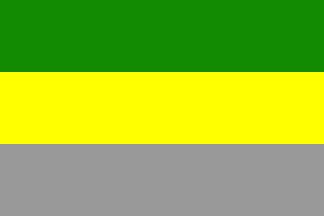 image by Ivan Sache, 8 January 2019
image by Ivan Sache, 8 January 2019
The flag of IE Gimnasio de Educación Media de Quibdó (Chocó Department) is
horizontally divided green-yellow-gray.
https://aprendoinformaticausandotic.wordpress.com/i-e-g-e-m, Yassi Orlidis
Mena Díaz' blog
Ivan Sache, 8 January 2019
 image by Ivan Sache, 18 January 2009
image by Ivan Sache, 18 January 2009
"Colegio Distrital Técnico Menorah" was set up by
Contract No. 771 signed on 14 December 1974 between the Secretary
of Education of Bogotá and the B'nai B'rith Jewish Ladies'
association. The Menorah Foundation, set up on 22 November 1993
in Bogotá and incorporated on 22 April 2003 in Miami, USA, is in
charge of the equipment and management of the institute.
The menorah, a seven-branched candelabrum, has been a symbol of
Judaism for almost 3000 years and is the emblem of Israel.
The flag of the institute, as shown graphically on the website
of the institute, is horizontally divided
white-blue-white-blue-white.
Overall and respective stripe proportions are not given, but it
can be assumed they fit the specifications of the national flag
of Israel.
Ivan Sache, 18 January 2009
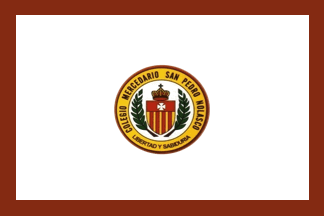 image by Ivan Sache, 13 May 2021
image by Ivan Sache, 13 May 2021
Colegio Mercedario San Pedro Nolasco was established in 1964 in Bogotá
by the Order of Our Lady of Mercy and Redemption of the Captives
(Mercedarians), a congregation established in 1218 in Barcelona by St.
Peter Nolasco (1189-1256; canonized in 1629 by Pope Urban VIII).
The flag of Colegio Mercedario San Pedro Nolasco is white with a wine
red border and the coat of arms of the Mercedarians in the center.
White represents the immaculate conception of the Blessed Virgin.
Wine red represents the Mercy's fourth vow, to give life.
The shield of the Mercedarians features the cross of the cathedral of
Barcelona, which was offered by the bishop to St. Peter Nolasco to
support his redeeming work.
The red and yellow pallets represent the king of Aragón, who offered his
arms to St. Peter Nolasco to support his redeeming work.
Source: school website
Ivan Sache, 13 May 2021
 image by Ivan Sache, 10 September 2022
image by Ivan Sache, 10 September 2022
I.E. Mercedes Ábrego is located in Palmira (Department of Valle del Cauca).
The flag of I.E. Mercedes Ábrego is horizontally divided yellow-white with
the school's emblem in the center.
https://mercedesabregopalmira.edu.co/simbolos-de-nuestra-institucion -
School website
Ivan Sache, 10 September 2022
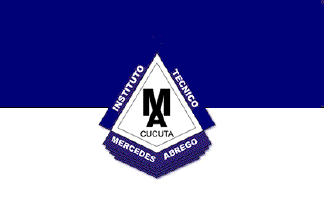 image by Ivan Sache, 19 July 2014
image by Ivan Sache, 19 July 2014
Instituto Técnico Mercedes Ábrego is located in Popular borough, part of the
municipality of Cúcuta (Norte de Santander Department). The institute was formed
by the merging of Instituto Técnico Comercial Mercedes Ábrego (est. by Ordinance
No. 28 of 21 November 1960), Colegio Hijo del Educador (est. by Decree No. 95 of
3 November 1985), Escuela Sagrado Corazon No. 3 and Escuela Sagrado Corazon No.
4 (both est. by Decree No. 199 of 5 March 1954), prescribed in 2002 by by
Departmental Decree No. 810. The institute is named for Mercedes Abrego de Reyes
(1770/75-1813), a patriot from Cúcuta who was summarily executed by the Royalist
troops after she had cut a brigadier's uniform for Simón Bolivar.
The
flag of the institute is horizontally divided blue-white with the institute's
emblem in the middle.
http://www.institutotecnicomercedesabrego.edu.co/home/inicio/index.jsp -
Institute's website
Ivan Sache, 19 July 2014
 image by Ivan Sache, 8 January 2009
image by Ivan Sache, 8 January 2009
"Liceo Feminino 'Mercedes Nariño'" was founded on 5
October 1916 in Bogotá by Priest Diego Garzón, as
"Sindicato de la Aguja, Artes y Oficios" (Syndicate of
Needle, Arts and Works) to prepare women to household work. The
institute was later renamed "Escuela Departamental Superior
de Artes y Oficios para señoritas" (Departmental Higher
School of Arts and Works for Women) and "Liceo Femenino de
Cundinamarca" (1958). On 18 June 1960 (Decree No. 778), the
institute was dedicated to Mercedes Nariño, the daughter of the
precursor of the national independence, Antonio Nariño.
The flag of the institute, as shown graphically and described on
the website
of the institute, is horizontally divided blue-white-red.
Blue represents loyalty, confidence, knowledge, intelligence,
faith, truth and eternal heavens.
White is associated to light, kindness, innocence and purity; it
is considered as the colour of perfection.
Red represents energy, vitality, power, force, passion, value,
aggressivness and courage.
Ivan Sache, 8 January 2009
"Corporación Universitaria del Meta" (aka Unimeta)
was founded on 16 November 1982 in Villavicencio. Redacted by
Rafael Mojica García, the statutes of the university were
approved on 28 March 1983. The university was recognized by the
Ministry of National Education on 5 August 1985 (Decree No.
12249, published in the Colombian official gazette on 16
September 1985).
The flag of the university is prescribed by Decree No. 009 of 31
August 1988, signed by Rector Rafael Mojica García.
"Article 1.
The flag of the "Corporación Universitaria del Meta"
shows on a reseda yellow ("gualda") background a
cardinal red ("purpurada") St. Andrew cross stretching
diagonally over the flag. On the cross are placed six blue stars
representing the areas of knowledge prescribed in the university
statutes.
Article 2.
The colours match the patriotic colours."
The Decree is given on the university
website, together with a colour photo of the flag. If I
understand correctly Article 2, the colours should be the same as
on the Colombian national flag. On the photo, the yellow
background has faded to white and the saltire is not symmetrical,
reaching the corner of the flag only in the upper right part.
Ivan Sache, 17 December 2008
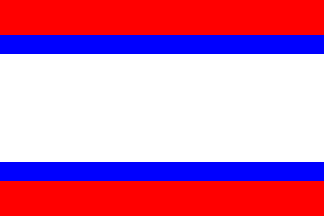 image by Ivan Sache, 14 November 2010
image by Ivan Sache, 14 November 2010
Colegio Miguel Antonio Coro (COLMAC), located in Bogotá, was founded in 1951
by Adriano Beltrán Acuña, who transferred in 1977 the institute's ownership to
Sociedad Tecnológica y Educativa Ltda. The institute is named for the
classicist scholar and Conservative politician Miguel Antonio Caro (1843-1909),
President of the Republic in 1892 and 1894-1898.
The flag of COLMAC is shown on the institute's website as horizontally divided
red-blue-white-red-blue, 2:1:6:1:2. White represents peace; to stress the need
of harmony and sincere unity among the institute's members, the white stripe is
placed in the middle of the flag and its height is equal to the cumulated height
of all the other stripes. The red stripes represent the youth vigor, the
commitment to study, the joy shared by the institute's members and their
eagerness in the quest of greatness. The blue stripes represents infinite
heavens fostering deep ecstasy.
Source:
http://www.colmac.edu.co/paginas/nuestro_colegio_texto.htm
The flag is shown on several photos available on the institute(s website, for
instance:
http://www.colmac.edu.co/paginas/galeria_fotos_semana_cultural2010_texto.htm
- Culture week, 2010
http://www.colmac.edu.co/imagenes/galeriasemanacultural2010/foto_sem_cultural2010_5_g.jpg
http://www.colmac.edu.co/paginas/galeria_fotos_inauguracion_olimpiadas2010_texto.htm
- Sports festival, 2010
http://www.colmac.edu.co/imagenes/galeriaolimpiadas2010/foto57_g.jpg
http://www.colmac.edu.co/paginas/galeria_fotos_grados2009_texto.htm -
Graduation ceremony, 2009
http://www.colmac.edu.co/imagenes/galfotosgrados2009/foto_grados4_g.jpg
Ivan Sache, 14 November 2010
"Institución Educativa Departamental 'Miguel Antonio
Caro' " (IEDMAC) was founded, as "Unidad básica",
on 20 May 1997 (Municipal Decree No 6) at Funza, Department of
Cundinamarca, mostly to handle the numerous students who had been
expelled from the other institutes of the
municipality. Per the Departmental
Decree No 9786 of 21 November 2007, the institute has
now eight seats (Miguel Antonio Caro, Policarpa Salavarriata, San
José, San Andrés, María Immaculada, Jardín Infantil,
Vivencias, La Unidad and Retorno al Aula).
The institute is named after the classicist scholar and
Conservative politician Miguel Antonio Caro (1843-1909),
President of the Republic in 1892 and 1894-1898.
The flag of IEDMAC, as
shown graphically
and described
on the website of the institute, is horizontally divided celeste
blue-white with nine yellow sons representing the nine seats of
the institute, placed horizontally over the border of the to
fields. (The nine suns also appear on the crown surmounting the emblem
of the institute).
Ivan Sache, 28 March 2009
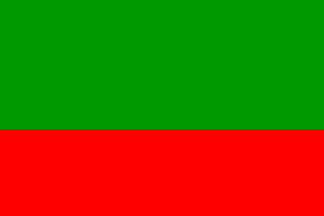 image by Ivan Sache, 18 January 2009
image by Ivan Sache, 18 January 2009
"Institución Educativa Distritál 'Miguel de Cervantes
Saavedra'" was set up on 27 August 2002 by the Federal
District of Bogotá (Decree No. 2524), succeeding "Centro
Educativo Distritál de Educación Básica y Media 'Miguel de
Cervantes Saavedra', which had been founded on 11 August 1997
(Decree No. 5581) by the merging of "Colegio La
Marichuela" and "Colegio 'Miguel de Cervantes de
Saavedra'"
The flag of the institute, as shown graphically and described on
the website
of the institute, is horizontally divided green-red (2:1).
Green represents vitality, youth, hope, respect and dedication.
Red represents fluor, humor, victory and liberty.
Ivan Sache, 18 January 2009
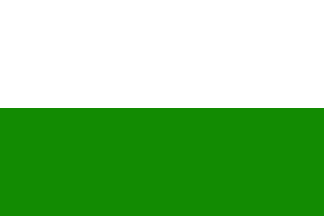 image by Ivan Sache, 19 October 2018
image by Ivan Sache, 19 October 2018
Institución Educativa Escuela Normal Superior Miguel de Cervantes Saavedra is
located in San Juan Bautista de Guacarí (Valle del Cauca Department).
The
flag of IE ENS Miguel de Cervantes Saavedra, designed by Héctor Gerardo Troches,
is horizontally divided white-green.
White is a symbol of peace and progress.
Green is a symbol of aspiration to progress in a peaceful context.
http://horizonteinstitucionalnormalguacari.blogspot.com/2016/07/mision-la-institucion-educativa-escuela.html
Ivan Sache, 19 October 2018
 image by Ivan Sache, 5 March 2017
image by Ivan Sache, 5 March 2017
Institución Educativa Millán Vargas originates in a boy's school established
in 1958 in the Millán Vargas borough, part of the municipality of Sampués,
Department of Sucre. Originally known as La Chivera, the borough was totally
destroyed by a blaze on 27 March 1957; the rebuilding of the borough was
organized by the Governor of Bolívar, Miguel Millán Vargas, for whom it was soon
renamed. The school was officially organized by Decree No. 25, adopted on 23
February 1963 by the Government of Bolívar.
http://iemillanvargas.edu.co -
Institute's website
The flag of the institute, adopted in 1975, is
divided red-blue by the ascending diagonal. Red is the colour of love, of
commitment to the educational process and of the connection of human beings with
their natural environment. Blue is the colour of aspiration to knowledge and
education.
http://iemillanvargas.edu.co/simbolos - Institute's website
Ivan
Sache, 5 March 2017
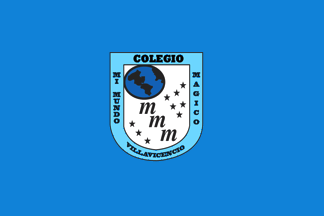 image by Ivan Sache, 3 January 2021
image by Ivan Sache, 3 January 2021
Colegio Mi Mundo Mágico (My Magic World) was established in 1982 in
Villaviciencio (Meta).
The flag of Colegio Mi Mundo Mágico is celestial
blue with the school's coat of arms in the center.
Celestial blue is a symbol
of the immense innocence, clarity and transparency of the children of the world.
The emblem represents the word full of fantasy and illusions that children
enjoy, without any kind of violence and evil.
http://www.mimundomagico.edu.co/index.php/simbolos
School website
Ivan Sache, 3 January 2021
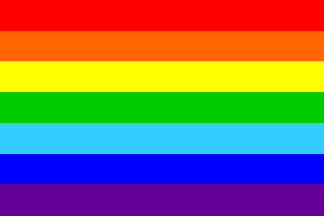 image by Ivan Sache, 10 March 2017
image by Ivan Sache, 10 March 2017
Colegio Cooperativo Minuto de Dios was established in 1973 by Rafael
García-Herreros Unda (1909-1992), founder in 1958 of Corporación Educativa
Minuto de Dios, which manages now 24 educational institutes all over Colombia,
and Andrés Emiro Díaz Contreras.
http://www.colegiosminutodedios.co/cooperativo/index.php - Institute's
website
The flag of the institute is horizontally divided
red-orange-yellow-green-light blue-blue-purple.
http://www.colegiosminutodedios.co/cooperativo/index.php/quienes-somos/nosotros/simbolos
- Institute's website
Ivan Sache, 10 March 2017
This flag is likely based on International
Co-operative Alliance Organization’s flag of 1925.
António
Martins-Tuválkin, 17 March 2017
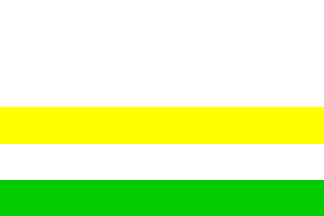 image by Ivan Sache, 9 July 2014
image by Ivan Sache, 9 July 2014
Instituto Técnico Misael Pastrana Borrero - Paz y Futuro was established
in Cúcuta (Norte del Santander Department) by Departmental Ordinance No. 2 of
12 May 2000, as Instituto de Educación Media Técnica Misael Pastrana Borrero.
The institute set up a convention with the social and educational corporation
Paz y Futuro (Peace and Future), approved by Departmental Ordinance No. 28 of
21 July 2000. Instituto Técnico Misael Pastrana Borrero - Paz y Futuro was
established by Decree No. 891 of 30 September 2002, which merged Instituto de
Educación Media Técnica Misael Pastrana Borrero with Colegio Básico San Pedro
Claver No. 64, Colegio Básico San Mateo, Colegio Básico María Goretti No. 18,
Colegio Básico Julio Pérez Ferrero, Colegio Básico Club de Leones No. 29, and
Escuela Santísima Trinidad. Decree No. 204 of 11 February 2003 incorporated Colegio Básico Guaimaral No. 25 to the institute and detached Colegio Básico
Julio Pérez Ferrero from it. Colegio Básico Guaimaral No. 25 was eventually
detached from the institute by Decree No. 774 of 21 July 2003.
The
institute is named for the lawyer and politician Misael Pastrana Borrero
(1923-1997), President of the Republic of Colombia from 1970 to 1974.
The flag of the institute is horizontally divided white-yellow-white-green
(3:1:1:1).
White is a symbol of the pure, immaculate and great Creator; it is
a symbol of kindness and purity, of everything. Yellow is a symbol of the
spiritual resources, of energy and of value. Green is a symbol of aspiration
in a promising future, is the colour of the land and fields, and is symbol of
the strength of nature and an invitation to leave in peace with the natural
environment.
http://www.colmisaelpastranaborrero.edu.co/Cucuta/index.php?option=com_content&view=article&id=58&Itemid=60
Ivan Sache, 9 July 2014
 image by Ivan Sache, 15 October 2018
image by Ivan Sache, 15 October 2018
Jardin Infantil Mis Pequeñas Personitas is located in Cúcuta (Norte de Santander
Department).
The flag of Jardin Infantil Mis Pequeñas Personitas is
horizontally divided blue-red with a white disk in the center, charged with the
school's emblem.
Blue is the color of the sky and the sea, associated with
stability and depth. Blue represents loyalty, trust, wisdom, intelligence,
faith,
truth and the eternal sky.
Red is the color of fire and energy, of
force, determination, passion and love.
The emblem features children and the
world. It is a symbol of equality of gender, race, age class, religion and
social condition.
Ivan Sache, 15 October 2018